Cannabis
growing 101
The Beginner's Guide to Growing Weed
Whether you're just getting started growing marijuana or already working in the industry, you'll find plenty of useful information and resources in our guide to take your weed growing to the next level.
Let’s grow cannabis!Homegrowing Map of the USA
Before you can grow your own weed, you need to find out whether growing is even allowed in your state. Our interactive map of home weed growing show in which states cannabis homegrowing is allowed.
hover the state and click on it

A cannabis plant consists of a flower, cola, bracts, trichomes, node, fan/sugar leaves, stem, and pistils/stigmas.
Cannabis plants are normally classified into four categories: Indica, Sativa, Hybrid and Hemp. Most homegrow enthusiasts will focus on growing hybrids, as well as pure Sativa and pure Indica strains.
Marijuana plants can be male, female or hermaphrodite. To tell the sex of a cannabis plant, it’s necessary to look at the plant's stem, where nodes with leaves and branches are connected.
Find out more about cannabis anatomy
 Trichomes
Trichomes
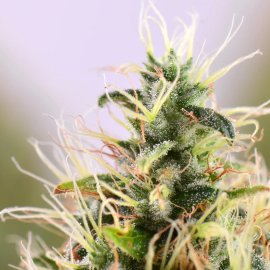 Pistils
Pistils
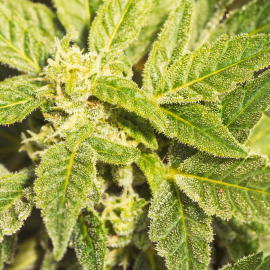 Sugar leaves
Sugar leaves
 Bracts
Bracts
The never-ending debate between outdoor cannabis growing enthusiasts and indoor marijuana growing aficionados has been raging on for decades. Control and consistency versus natural sunlight and open land — both growing methods boast unique and undeniable advantages.
In addition, a third party is entering the conversation — greenhouse growers — who take and combine the best features from both the indoor and outdoor cannabis growing worlds.
When deciding on the future growing medium where you’ll be cultivating your cannabis, consider the following factors:
- your local climate
- available space
- costs
- product quality
Cannabis plants need sun and warmth to grow. Latitude also plays a major role in cannabis growing, as it directly affects daylight hours. Whether you live in a city or a rural area will also influence your choice. Finances are crucial, too, since running a cannabis farm is significantly more expensive than just growing a couple of weed plants in your apartment.
Find out more about cannabis growing mediums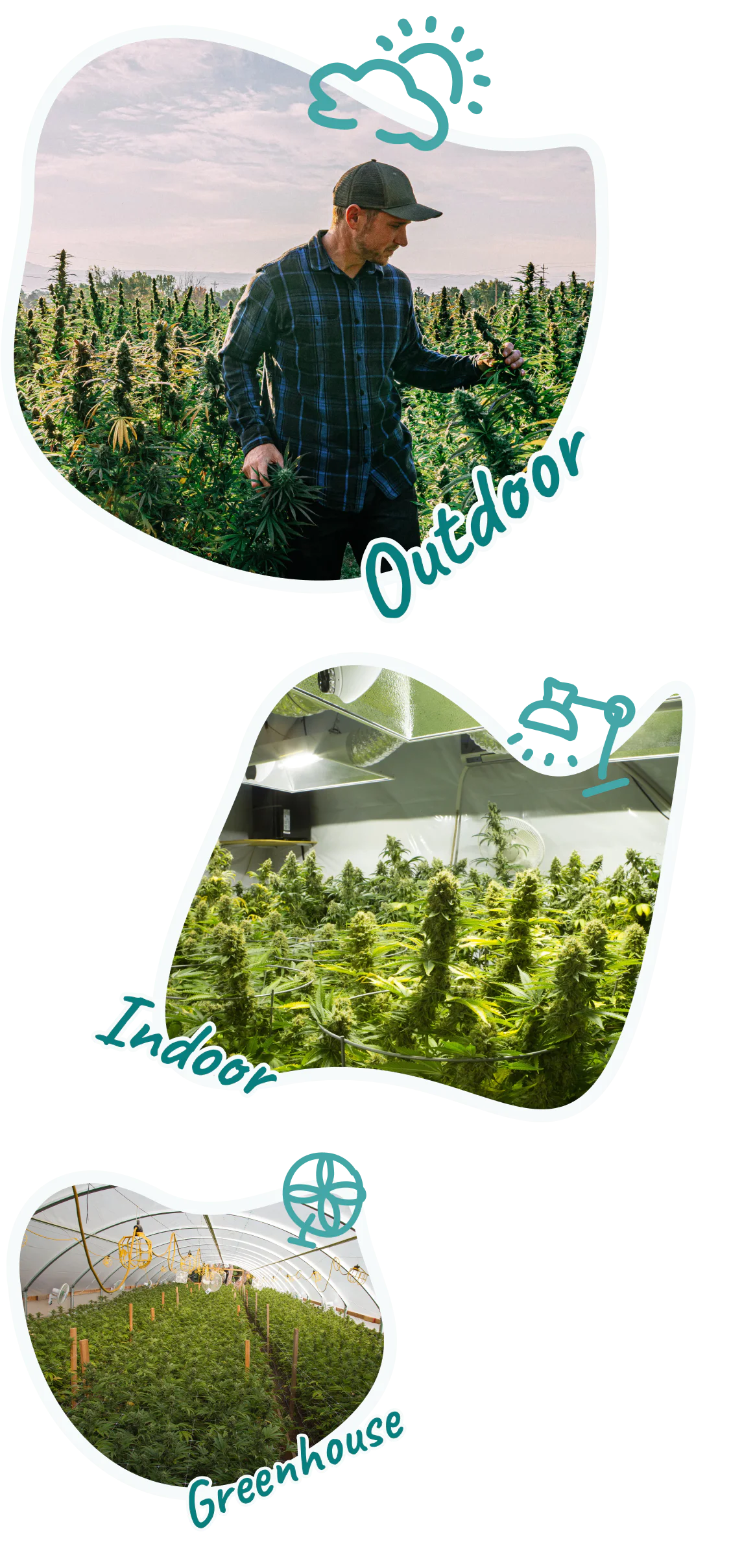
Propagating is the process of using one cannabis plant to create more plants. There are two ways to propagate new marijuana plants — cloning and seeds.
Cloning is a time-tested method of creating new cannabis plants from already existing ones. At the node stem of a marijuana plant, growers carefully cut a branch, place it into a starter growing medium, and, when the roots are developed, place the branch in a larger container or ground. There, the new plant will grow further into a full-bodied cannabis tree. The major benefits of cannabis cloning include shortening the growing process and avoiding having to browse for seeds and spend money.
Growing from seeds is a method of creating new cannabis plants from scratch. This method is perfect for beginner growers because it allows them to create new plants and strains while also witnessing the entire growing process - from a tiny seed to a mature cannabis plant. We’ve prepared detailed guides on each of the cannabis growing methods for you to explore.
Find out more about cannabis propagating
Cloning doesn’t mean
what you think it means
Cannabis is believed to have evolved in Central Asia. Its forefather strains are known as landrace strains, and were used by weed cultivators to create modern marijuana strains. The new strains adapted to their new environment, leading to a yield change, unique properties, and a different smoking experience.
As a cannabis grower, you’ll be cultivating new cannabis strains, which also will be adapting to a specific growing environment, creating new flavors, tastes, different yields and growing times, as well as unique cannabinoid and terpene profiles.
A cannabis plant has nearly 420 chemical entities, more than 60 of which are cannabinoids. The most notable cannabinoid is the phytocannabinoid tetrahydrocannabinol (THC) (Delta9-THC or Delta8-THC). Cannabidiol (CBD) is another major constituent of the plant, which, alongside THC, directly affects the potency and psychoactive activity of cannabis.
Where does cannabis get its flavor and aroma? Oils called terpenes are responsible for weed’s taste and smell, as well as its unique smoking experience. Terpenes affect the way THC works in the human body. Indica, Sativa, and hybrids all have different terpene profiles.
Find out more about cannabis strains

Who in their right mind comes up with strain names like these?!
Obvious Answer: In Your Right Mind ;)Whether you’ll be growing indoors or outdoors, you can choose from two flowering types of cannabis plants, which will allow you as a grower to enjoy the best yield: photoperiod and auto-flowering. In addition, you can go for feminized seeds if you want to grow female plants.
Photoperiod cannabis is the basic type of cannabis that has existed for thousands of years. Perfect for growing outdoors, photoperiod plants stay in their vegetative state longer, can be used to breed new strains, and have a higher average yield.
Unlike photoperiod plants, auto-flowering cannabis doesn’t require a change in lighting hours to move from a vegetative to a flowering stage, which is very useful for novice growers. But auto-flowering plants grow smaller, provide lower yield, and can’t be used for breeding.
Feminized cannabis plants get all the hype in today's weed cultivation world. Feminized marijuana plants are genetically modified to eliminate male seeds. It’s done because female plants contain buds, which are incredibly popular among smokers because they produce more THC and CBD while offering higher yields.
It is worth noting that when a cannabis plant is put under too much environmental stress, the plant can develop both male and female flowers, which is called hermaphroditism and is not welcomed by growers. Hermaphroditism negatively impacts the quantity and quality of yields.
Find out more about cannabis types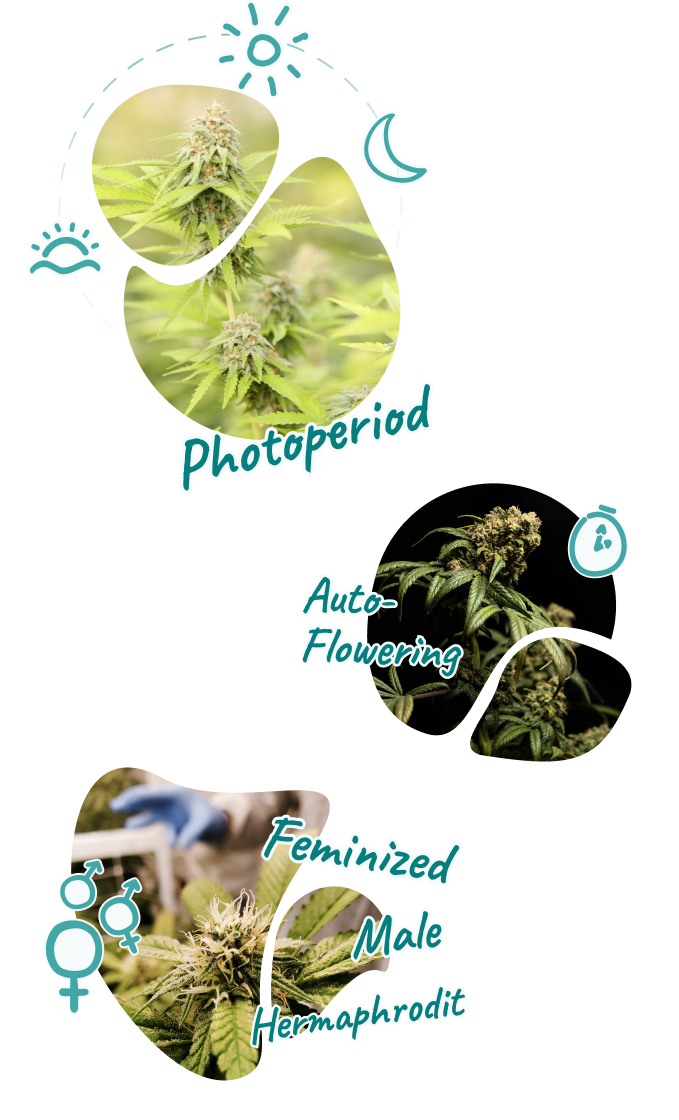
Finally, your gardening lessons will come in Handy
The life of a cannabis plant starts from the seed. The process of growing cannabis from a seed to a sprout is called germination.
Cannabis germination is usually affected by light, temperature, water, soil type, and air quality.
We recommend that beginner growers start their cannabis journey growing indoors, because a tiny cannabis seed will have a greater chance to successfully germinate. Although putting a seed directly in soil outdoors is possible, it’s too risky and seldom used even by experienced growers.
There are several cannabis germination methods:
- Paper towel
- Plastic container
- Peat moss
- Coco perlite
- Rockwool
- Hydroponics
- Directly in soil
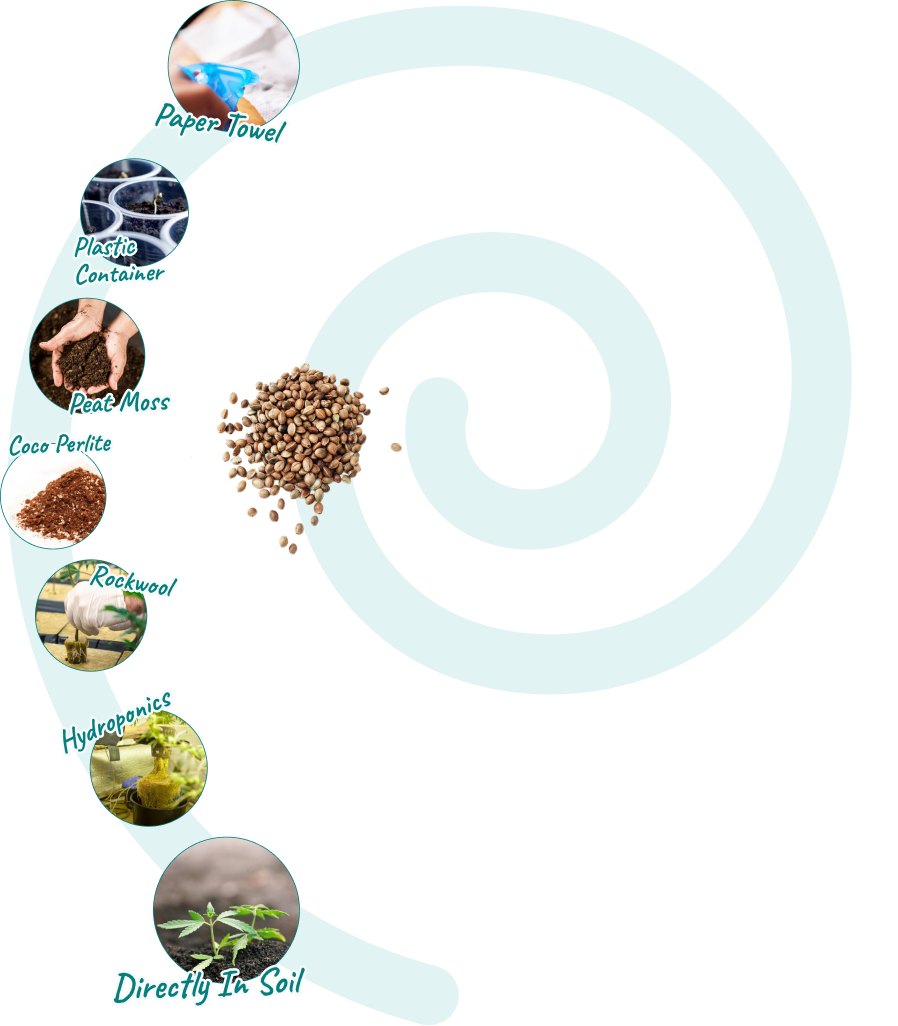
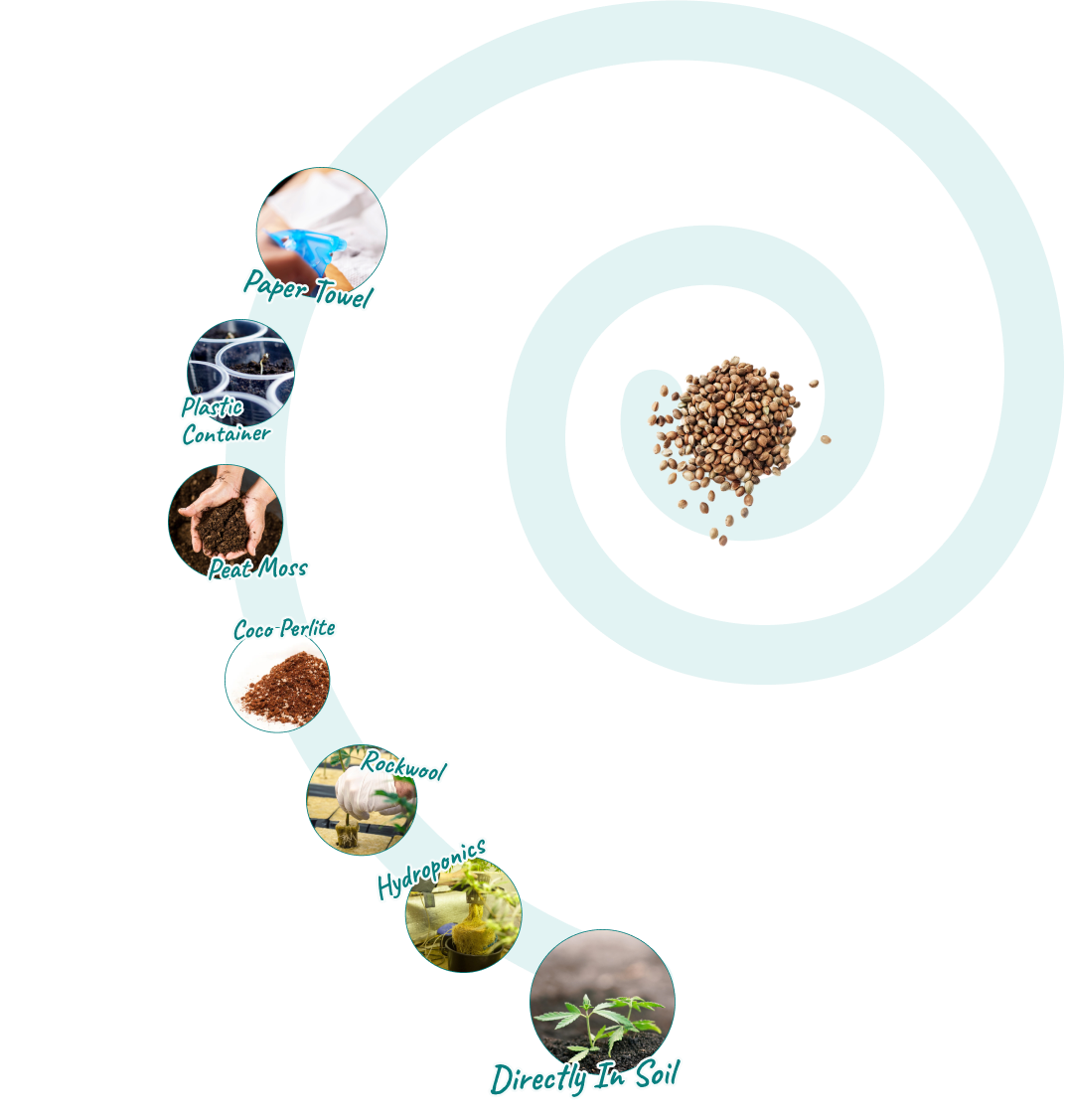
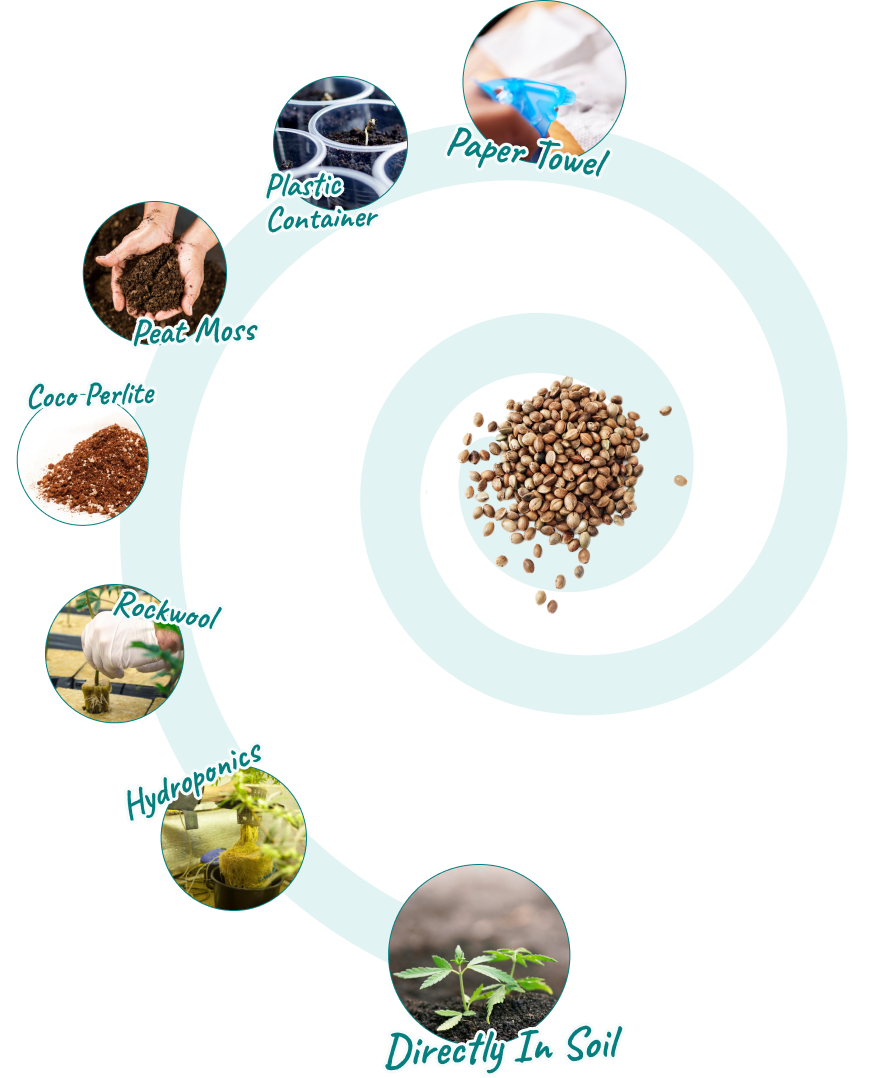
Get your copy and learn later
Plenty of useful information and resources in our guide to take your weed growing to the next level.
As cannabis seeds begin growing into plants, you’ll need to move them to bigger containers. The process of transplanting a cannabis plant from its initial container to a bigger pot is called “re-homing.”
To grow healthy and strong, as well as to flourish, a cannabis plant needs more space to spread out and avoid becoming “rootbound,” which negatively affects the plant's quality. The bigger the re-homing container is, the larger and healthier a plant will grow.
When grown indoors, a cannabis plant will most likely undergo two transplanting stages. In four to eight weeks after germination, a plant will travel from the first (1 gallon) to its second (2 gallons) and, most likely, final container. Two weeks before flowering, some plants will need to move to the third and largest (5 gallons) container. Keep in mind that using a giant pot from day one is not a good idea. If a seed doesn’t pull through, you’ll be wasting soil. A small plant usually doesn’t receive enough water in a big pot, because the water spreads over the entire pot.
Before the plant reaches its flowering stage, there has to be plenty of space for its roots in either the final pot or in soil (whichever you decide).
Find out more about indoor cannabis transplanting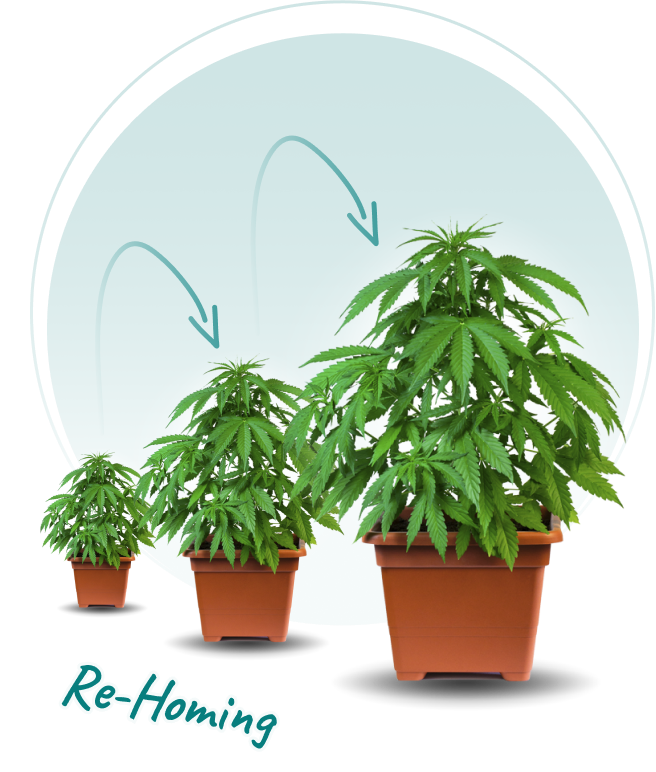
Similar to us growers, cannabis plants prefer temperatures that are not too hot and not too cold.
As an indoor cannabis grower, you'll have to make sure the temperature range is just right. In general, marijuana plants grow best in 70-85°F (20-30 °C) temperatures during the day when the lights are on. When the lights turn off (“night mode”), cannabis plants need slightly cooler temperatures.
During a vegetative stage, cannabis plants prefer temperatures from 68 to 77°F (19-25°C). During a flowering stage, growers should keep temperatures a little bit lower, about 65-80°F (18-26°C).
Correct temperature settings are key to growing healthy and potent cannabis.
Find out more about indoor growing temperatures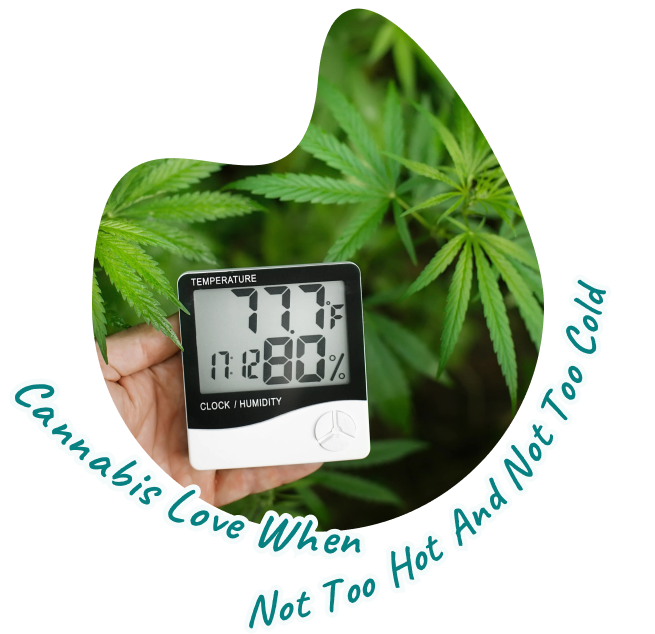
Please try not to confuse °F
with °C… again
cannabis Lullabies?
Cannabis growing stages (vegetative and flowering) are influenced by the hours of light and darkness the plants receive. Depending on whether you’re growing your weed indoors or outdoors, the plant will undergo different schedules and amounts of time under light versus darkness. To successfully grow cannabis indoors, you'll have to mimic the plant’s natural growth pattern.
During the vegetative stage of auto-flowering plants, we recommend providing the plant with a minimum of 18 hours of growing light (also known as 18/6). If you want your plant to reach its maximum growth capacity, you may want to keep your cannabis under 24 hours (24/0) of indoor light for as long as 60 days (given you have enough space to do so). This is the optimal time period to unlock the full potential of your plant to grow flowers. For photoperiod plants, light patterns depend on the hours of natural light and darkness.
To move from their vegetative stage to the flowering stage, your plant must be exposed to 12 or more hours of darkness each day. You should start flowering once your plant reaches the desired height and size.
Find out more about exposure to light and darkness
Aeration (also known as soil aeration or oxygenation) is the process of puncturing the soil to achieve better water penetration and introduce more oxygen into the soil.
Outdoor aeration is usually performed with manual or mechanized equipment that removes cores of soil from the top layer or simply punctures the soil with spikes. Indoor growers may use the same method, but usually they will adjust the soil composition to allow greater oxygenation and water absorption.
Aeration for indoor gardening is incredibly important. Cannabis plants must absorb nutrients from the soil to develop successfully. The soil solution, a mixture of water and soil surrounding the plant’s roots, is the medium where nutrients dissolve. By making the soil porous to allow water to penetrate deeper into the soil, aeration helps absorb more water and retain nutrients needed for cannabis to grow properly.
To make the soil porous, aeration involves using soil additives, including tree bark, twigs, dried leaves, grass clippings or sand. Vermiculite, which is a common mineral often used for insulation and water retention, may also be used to increase soil aeration.
Indoor growers perform aeration when the plant is placed in the growing pot for the first time. The 30% soil additives (one or several) and 50% soil aeration mixture is used by most indoor growers. However, some growers use a one-to-one ratio of aeration mixture and soil, depending on the type of cannabis plant, sunlight patterns, and watering protocol.
Another important aspect of growing healthy cannabis plants is ventilation. Giving your homegrown weed enough fresh air initiates photosynthesis, which helps absorb nutrients. Without ventilation, cannabis plants can’t consume nutrients and will literally starve. Proper ventilation also prevents pests and diseases from infecting the plants.
Find out more about cannabis aeration
A friend with weed is a friend indeed, and a friend who shares is a friend who cares
As you’ve already learned, factors such as lighting, aeration, ventilation, CO2, temperature, and humidity are key to cultivating healthy cannabis plants and obtaining high yields. As a grower, to avoid modifying your living space to fit your cannabis cultivation needs, you can consider opting for a growing tent or a growing box. Its temporary construction, usually matte black on the outside and gleaming on the inside for stealthy growing, provides a dedicated space for hanging lights and fans, as well as other appliances required for growing.
Using a growing tent, you will be capable of creating the best environmental conditions for your plants to develop. A growing tent will protect your kush from mold and pests, while the mesh ventilation will protect the plants from dust and other pollutants.
Tents for cannabis growing have been used for decades. Choosing a tent as a growing space for your plants is affordable and easy to set up, suiting growers who aim for small growing operations of 1 to 5 ounces a month. The price for a regular growing tent is between $70 and $150.
Advantages of growing cannabis in a tent:
- Grow cannabis whenever you want at home or outdoors
- Easy environmental control
- Simple to set up
- Your home stays intact and the weed smell is contained
- Can be quickly taken down or hidden
- No extra electricity expenses
- No unwanted attention from nosy neighbors
Cannabis growing tents come in all shapes and sizes, ranging from a few square feet to full-blown mini-mansions with multiple compartments. Some tents are relatively simplistic, whereas others are rich in features.
Find out more about growing cannabis in a tent
how to tell the Partner about this renovation project?
Irrigation is an important aspect of growing cannabis. As a homegrower, you can choose conventional hand-watering, which has been used by covert growers for a millenia or install an irrigation system.
Watering cannabis by hand sounds pretty simple. Manually delivering the correct amount of water to the plant and counting the time in your head to calculate how much water each plant receives. You also need to time watering cycles in the right way.
The main issue with hand-watering is human error. Adding too much (or too little) water and nutrients and losing track of a proper watering schedule affects the plants’ ability to grow. That’s why growers should strongly consider investing in an automated irrigation system. The quicker, the better.
Drip irrigation is one of the simplest and most effective ways to automate the process of watering cannabis and feeding plants with nutrients. Relying on low pressure and volume, it automatically delivers water and nutrients to the plant’s root system in a precise and regulated fashion. Irrigation can be of two types — bottle and drip line.
Advantages of drip irrigation:
- Saves lots of water
- Laser-focused water and nutrient distribution
- Healthier root system
- Preserves soil quality long term
- Removes the need to water plants manually
For a novice grower, hand-watering is the way to go. However, if you have plants to grow more quality weed in larger quantities and collect greater harvests, you should definitely consider investing in drip irrigation.
Find out more about cannabis irrigation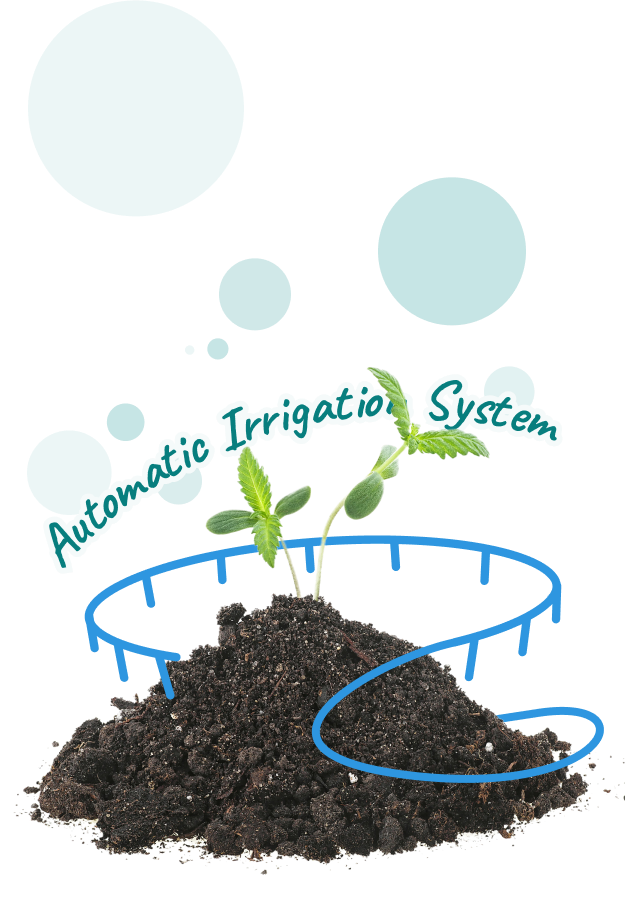

amounts of ganja, yah? Winston
Growing fat and juicy buds is every homegrower’s dream, isn’t it? To achieve this goal, tinkering with lights and adding only plain water won’t suffice. Nutrients, i.e., fertilizers, must be added to the mix so that the plant’s root system develops properly. They lay the foundation for quality yields, bringing growers joy in the form of great taste and aroma.
The essential macro and micronutrients needed for the plant to grow more leaves, which turn into flowers and then into buds, are contained in fertilizers. Fertilizers can be organic, chemical, synthetic, or mixed. Without fertilizers, your cannabis won’t reach its full potential.
Some of the most common types of fertilizers are vermiculite, perlite, human urine, wood ashes, bat guano, fish meal, worm castings, compost.
To grow healthy plants with succulent buds, a grower has to add the primary nutrients, collectively known as macronutrients or NPK:
- Nitrogen
- Phosphorus
- Potassium
In smaller quantities, cannabis needs the following micronutrients:
- Calcium
- Magnesium
- Iron
- Copper
- Boron
- Sulfur
In addition, a cannabis plant requires these non-mineral elements, absorbed from air and water:
- Carbon dioxide
- Hydrogen
- Oxygen
Throughout the different stages of growth, cannabis plants will need different amounts of the above nutrients. During the vegetative stage, high levels of nitrogen, medium phosphorus, and high potassium are must-haves. During the flowering stage, plants require higher amounts of phosphorus and potassium, as well as lower levels of nitrogen.
Find out more about cannabis fertilizers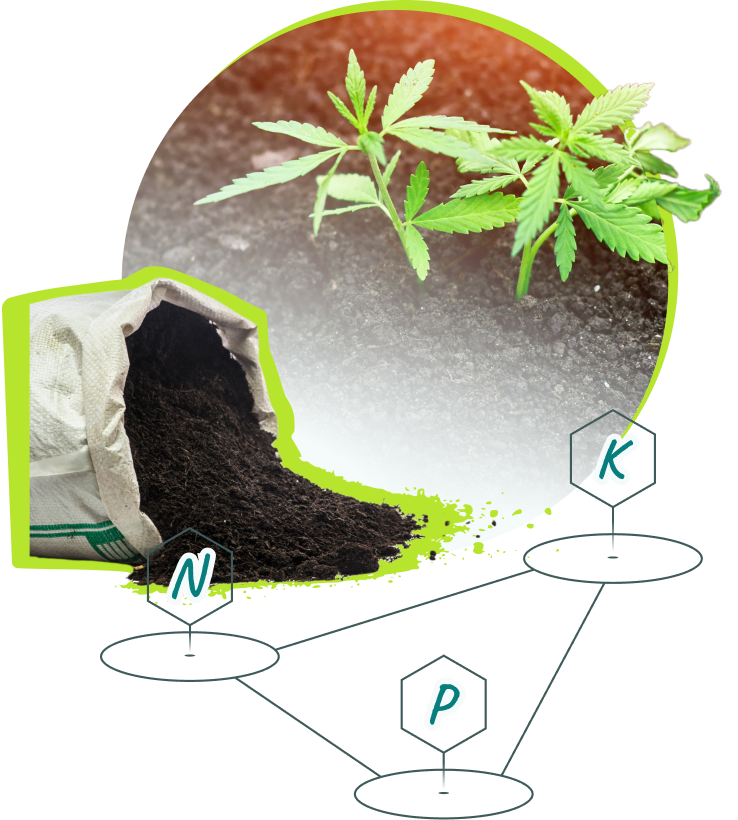
Growing cannabis might sound simple, but not until you try to grow it professionally and achieve any noticeable yields and bud quality. As the plant grows and matures, it goes through various stages, each requiring not only specific knowledge and care, but also different amounts of light, water and nutrients.
Summing up information from in previous chapters, cannabis plant development can be distinguished into four major stages:
- Germination stage (3 to 10 days)
- Seedling (2 to 3 weeks) and vegetative stages (3 to 16 weeks), which can also be called the pre-flowering stage
- Flowering (8 to 11 weeks)
- Harvesting
All in all, a cannabis plant takes somewhat from 10 to 32 weeks, or about 3 to 8 months, to become harvest-ready when grown from a seed. Using clones or auto-flower seeds will speed the process up.
Speaking of buds, the ultimate goal of every homegrower, they usually grow the most toward the end of the flowering stage. In the beginning, you won’t notice any serious bud growth. However, closer to the end of the flowering stage, the buds will be fully formed and stop developing. Once the buds mature, it will be high time for harvesting! YAY!
Find out more about cannabis growing stages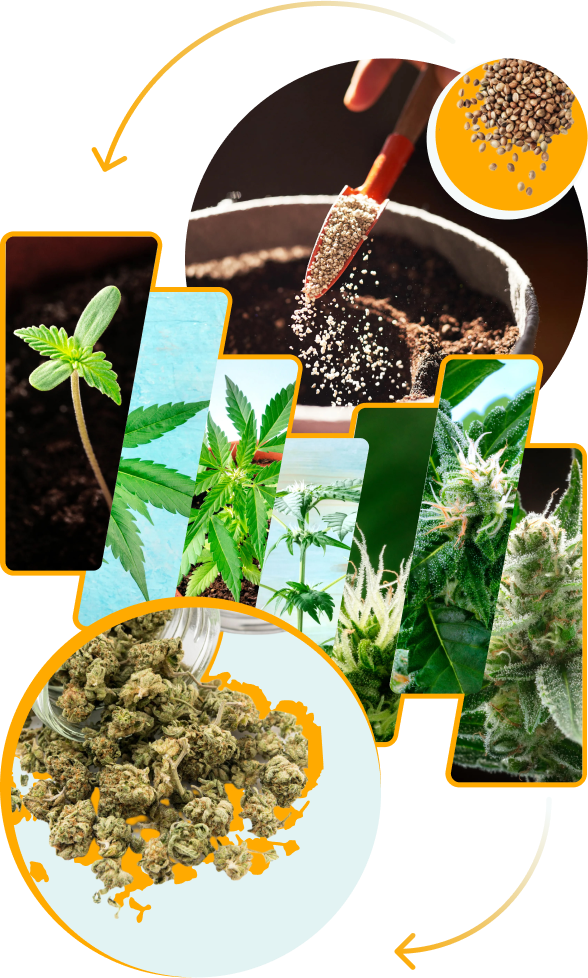
Mmmm, the moment you’ve been waiting for — harvesting! Feeling excited yet? You definitely should be, as all your time, effort, and knowledge put on the altar of growing cannabis at home is about to pay off (preferably, with juicy, savory buds).
Determining the right harvest time may vary from strain to strain, but there are several general indicators to begin harvesting:
- The leaves begin to yellow and curl, while some may fall off
- Branches hang more because they’re heavy with buds
- Buds are well-developed and no longer show potential for further growth
Previously, we’ve shared the approximate time required to complete each cannabis growth stage. But time isn’t the best indicator, as the correct harvesting moment will also depend on the strain, your location, growing conditions and the type of plant.
That’s why the most reliable way to tell that the plant is ready for harvesting is watching out for cannabis trichomes.
Shiny, sticky, fantastic-smelling crystals found all over cannabis flowers, trichomes can indicate whether the plant is ready for harvesting. Growers should pay attention to the color and opacity of trichomes. When trichomes change from clear to cloudy, that’s the best sign the plant is ready for harvesting. But when trichomes are still clear, it means the cannabis is still immature and requires another week or two to finish the flowering stage.
There’s a simple rule of thumb — it’s better to harvest cannabis a bit late than too early.
Find out more about cannabis harvesting
Growing cannabis at home is becoming more and more popular; however, weed is not your average houseplant. Be ready to tackle common pests, diseases, mold, environmental stress and nutrient deficiency, as well as temperature, watering, and light issues. But hey - no one said growing cannabis at home would be a walk in the park, right?
Nevertheless, cannabis is called “weed” for a reason! The plant is very resilient, which allows growers from all over the world to cultivate it at home. You just have to be prepared to deal with the most common difficulties growers face.
Forewarned is forearmed!
Find out more about cannabis growers' most common predicaments
Have you ever left a half-smoked joint on a table only to throw it away the next morning because it’s no longer any good? That’s because you didn’t store it properly, and your weed lost its properties when exposed to an external environment for some time.
That said, proper cannabis storing does matter because it allows, marijuana to stay fresh, delicious, and potent all year round. Just as you finish curing your cannabis, the harvest you wish to put away for later has to be stored the right way.
Storing cannabis is best done in the same half-gallon jars you use for curing. An air-tight container with a locking seal will do great. The goal is to store cannabis in a container that is as air-proof as possible.
Store cannabis in a temperate, dark place to avoid mold, powdery mildew and drying out, as well as to preserve flavor and potency for about 18 months. After that period of time, cannabis buds start to lose a considerable amount of their taste and properties. Make sure you don’t take too long to smoke your cannabis!
Find out more about storing homegrown cannabis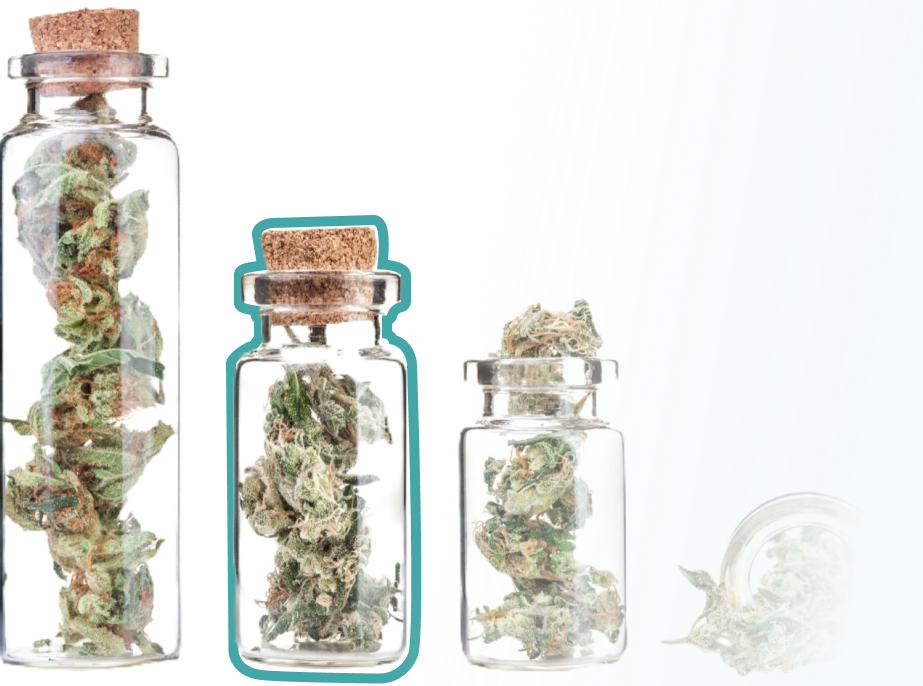

Let’s be honest — we grow cannabis at home mainly to consume it on our own or share it with friends. Most of the time, cannabis grown at home will be smoked using a joint, blunt, bubbler, bong (waterfall or gravity), pipe, or hookah.
However, there are several other (quite peculiar!) ways to use your marijuana and experience different effects. For example, cannabis can be used for making edibles — homemade snacks such as brownies or cookies that are used orally and offer a different kind of high.
Cannabis can also be used for vaping as many believe that vapor is less harmful than smoke.
Experienced users who are accustomed to high THC levels can consume cannabis in the form of dabs. The method is called dabbing, and it involves inhaling vaporized high-THC resin extract through glass pipes or bongs to achieve an even greater high.
Other ways of using cannabis are in the form of sprays, tinctures, and topicals, mainly for cosmetic and medical purposes.
Find out more about how to use cannabis grown at home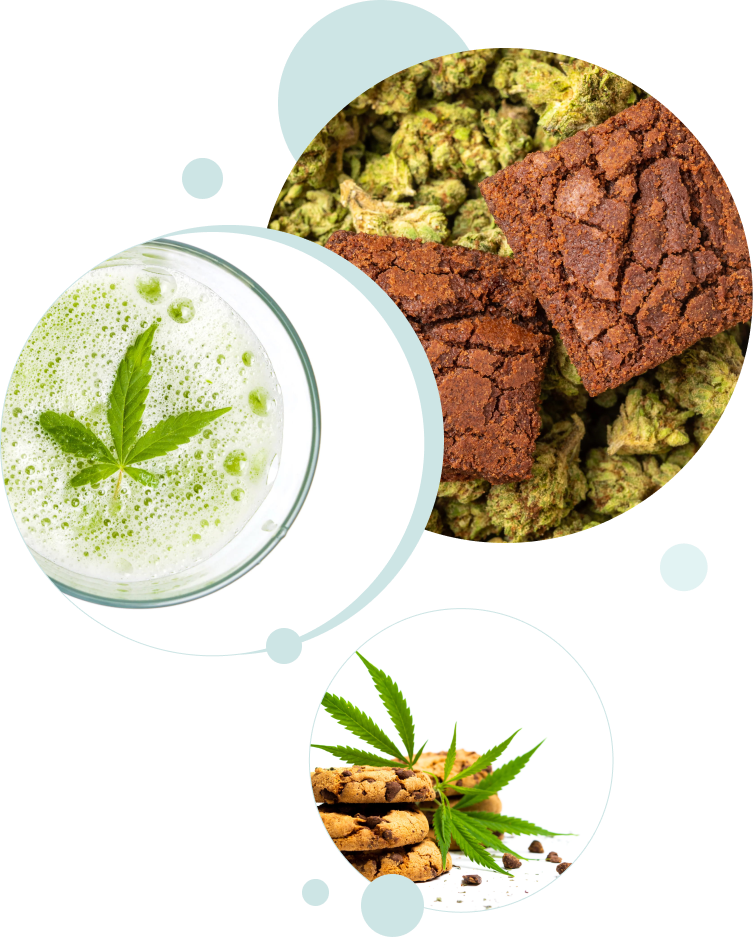


Growing cannabis takes time and effort. If you’re really passionate about growing your own weed, then there’s nothing left to do but roll up your sleeves and get growing. The entire AskGrowers.com team wishes you heavy yields, strong buds, and an overall pleasant homegrowing experience!
BTW, don’t forget to tell us about your outstanding cannabis growing achievements! Send us your photos and share growing stories with the community.
Get your copy and learn later
Plenty of useful information and resources in our guide to take your weed growing to the next level.